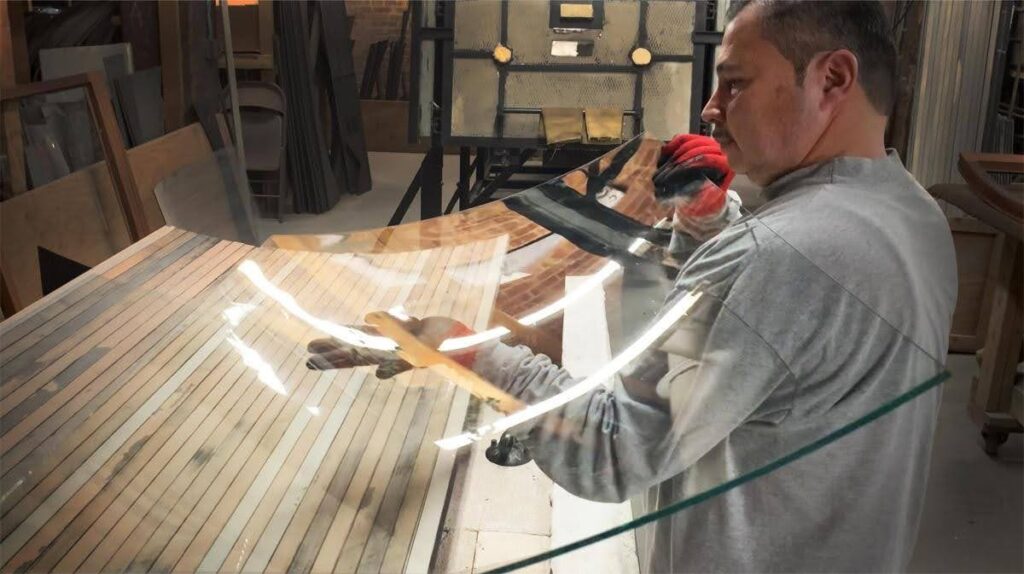In recent years, homeowners, architects, and designers have been placing a renewed emphasis on natural light. Once considered a luxury, ample daylight is now a must-have feature in modern homes. Floor-to-ceiling windows, open-plan layouts, and casement windows have become popular modern house window designs. Among the most visually striking and functionally effective solutions is curved glass, a material that not only transforms the aesthetics of a space but also revolutionizes the way sunlight flows into it.
This shift toward natural lighting is more than a design trend-it’s part of a broader movement toward sustainability, well-being, and energy efficiency. Curved glass, expertly crafted and customized by skilled artisans, offers a seamless solution to bring light deeper into interiors while elevating a home’s visual appeal. Let’s explore how curved glass installations maximize natural light and why they’re becoming a defining feature of modern homes.
The Problem with Artificial Light
Artificial lighting has long been used to supplement or replace natural daylight in homes, but it comes with environmental and psychological drawbacks. Most traditional lighting-particularly incandescent or halogen bulbs-consumes high levels of energy, contributing significantly to global electricity demand. Even with the rise of LED technology, artificial light is still energy-intensive when used throughout the day.
From an environmental perspective, this dependency increases greenhouse gas emissions and drives up energy bills. But the impact isn’t only external. Studies show that excessive artificial lighting, especially the cool blue tones emitted by many modern bulbs, can disrupt our circadian rhythms, contributing to poor sleep, eye strain, and mood disorders. This has led many homeowners to seek architectural solutions that reduce reliance on artificial light.
The Rise of Curved Glass in Home Design
Enter curved glass-a structural and decorative marvel that bends not only light but also the boundaries of traditional architecture. Skilled artisans can customize curved windows to fit any space, creating a stunning focal point that enhances the architecture and leaves a lasting impression. These elements are often tailor-made to blend with both modern and classic homes, opening up exciting design possibilities.
Unlike flat panes, curved glass offers a dynamic way to capture and redirect sunlight. It creates a fluid connection between indoors and outdoors, softening harsh angles and diffusing natural light more evenly across a room. When properly oriented and installed, curved glass panels act like subtle solar collectors-harnessing light and enhancing comfort without compromising energy efficiency.
Bending Sunlight into Interiors
Curved glass installations are particularly effective at drawing light deeper into a home’s interior. In spaces where flat windows may only illuminate part of a room, curved glass can be shaped to extend the angle of light entry, ensuring more comprehensive daylight coverage.
Panoramic Windows
A popular application is the panoramic curved window, often found in living rooms, dining areas, or master bedrooms. These sweeping installations allow sunlight to enter from multiple directions throughout the day. The curvature ensures that as the sun moves across the sky, its light continues to filter in, maintaining a consistent natural glow indoors.
Bay-Style Configurations
Similarly, bay windows-especially those crafted with curved glass-offer a soft, rounded alternative to the traditional box-shaped bump-out. Not only do they expand interior space, but they also create a “light well” that captures and distributes daylight. This setup brightens corners and nooks that typically remain shaded, reducing the need for lamps and overhead lighting during daytime hours.
Reducing the Need for Artificial Lighting
By enhancing daylight penetration, curved glass reduces the demand for artificial lighting during the day. This has a dual benefit:
- Lower Energy Consumption – Homes that rely more on natural light use significantly less electricity, with one study finding that households can save up to 50%. This contributes to lower utility bills and a smaller carbon footprint.
- Improved Lighting Quality – Natural light has a more accurate color rendering index (CRI) than artificial light, making interiors appear more vibrant and true-to-life. This is especially valuable in kitchens, studios, and living areas where color accuracy matters.
Over time, homeowners may find that their dependence on artificial lighting diminishes altogether during daylight hours-a win for both their wallets and the planet.
The Psychological Benefits of More Daylight
Designing homes to maximize natural light isn’t just about saving money or improving aesthetics-it also supports mental and physical well-being. Numerous scientific studies confirm the profound effect that sunlight has on mood, productivity, and health.
Improved Mood and Reduced Stress
Sunlight triggers the brain’s release of serotonin, a hormone associated with happiness and calm. Spaces filled with daylight often feel more inviting and relaxing, making it easier for occupants to unwind or focus.
Better Sleep
Exposure to natural light during the day helps regulate the body’s circadian rhythm, promoting healthier sleep patterns. This is especially beneficial in home offices and bedrooms where lighting directly affects rest and performance.
Enhanced Productivity
Natural lighting has been linked to increased concentration and reduced fatigue. In a post-pandemic world where many people work from home, having well-lit interiors can enhance daily routines and reduce the need for artificial stimulation.
Conclusion: Designing for Light, Living for Wellness
Curved glass installations represent a perfect blend of form and function. They enhance architectural beauty while solving one of the most fundamental challenges of interior design: lighting. By bending sunlight into interiors, curved glass not only minimizes our reliance on artificial lighting but also creates spaces that feel brighter, healthier, and more connected to the outdoors.
As the demand for sustainable, health-conscious homes grows, curved glass is poised to become a cornerstone of thoughtful residential design. Whether incorporated as a dramatic panoramic window, a sleek bay configuration, or even a curved glass skylight, this elegant material invites the sun to do what it does best-illuminate, energize, and uplift.
So the next time you consider renovating or building a home, remember this simple yet powerful principle: Let there be light-and let it shine through curves.

